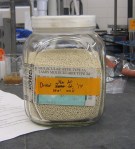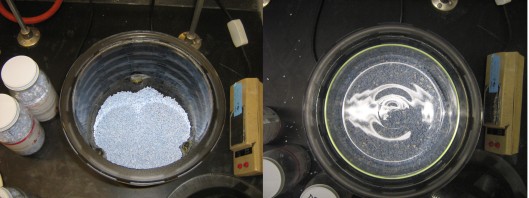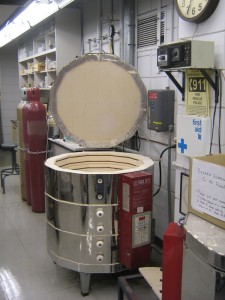 Sieves are a beautiful invention, as I’ve said before. At 10-20% w/v, 3A molecular sieves will dry every common solvent except acetone as well or significantly better than a solvent still [1, 2]. A bottle of sieves/solvent is also far less likely to catch on fire and is far cheaper to maintain (no argon or water lines).
Sieves are a beautiful invention, as I’ve said before. At 10-20% w/v, 3A molecular sieves will dry every common solvent except acetone as well or significantly better than a solvent still [1, 2]. A bottle of sieves/solvent is also far less likely to catch on fire and is far cheaper to maintain (no argon or water lines).
Unfortunately, sieves are shipped saturated with water and must be dried before use. Sieves actually absorb water at 120 degC, so a conventional drying oven is not up to the task.
Conventional wisdom is that heating to 300 degC or greater at atmospheric pressure will dry sieves, and this temperature can be reduced somewhat under vacuum [3]. Experimentally I had some success heating to ~200 degC overnight in a vacuum oven, but was never quite sure that the sieves were fully active [4].
Holding the sieves at 350 degC for 3.5 hours is the right amount of overkill. While this is a temperature out of reach of most drying ovens, it barely hits “medium” on the temperature setting of a glassblower’s annealing oven.
When drying sieves go for economy of scale. Large recrystallization dishes will hold up to about 4 kg at a time (190×100 mm), and have the advantage of being ~1.5 cm smaller in diametre than an average size glass desiccator. Once they’ve been activated let the sieves cool to ~150 degC in the annealing oven, then transfer them over. Take care to fill the desiccator with drying agent to at least the height of the inner glass studs, as contact between the hot recrystallizing dish and cold ceramic/glass will almost certainly shatter one or both.

Take care to cover the glass baffles (left) with drierite. The recrystallization dish should fit within the dessicator without touching the sides (right).
Active sieves can be stored in any convenient glass container, provided the lid is well sealed. Double wrapped parafilm works well, sufficient to keep the sieves active for at least six months.
[1] Sieves are mildly basic, which triggers aldol reactions in acetone and can decompose some compounds. For example, after prolonged storage (8-10 months) of triethylamine over 3A sieves I’ve noticed a yellow discolouration in the solvent, likely due to formation of diethylamine.
[2] Larger sieves are recommended for the drying of some solvents (ie. 5A for pyridine). The difference in final water concentration is pretty negligible though, and the larger sieves can trap solvents like methanol, reducing their utility.
[3] Flame drying in a roundbottom flask under vacuum was standard approach when I arrived in Alberta, but was good for only small quantities.
[4] How to determine if molecular sieves are active: Place a small quantity on a gloved hand, and add roughly two volume equivalents of water. If the sieves are fully active they will become too hot to hold, even through the glove.

